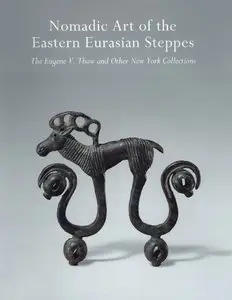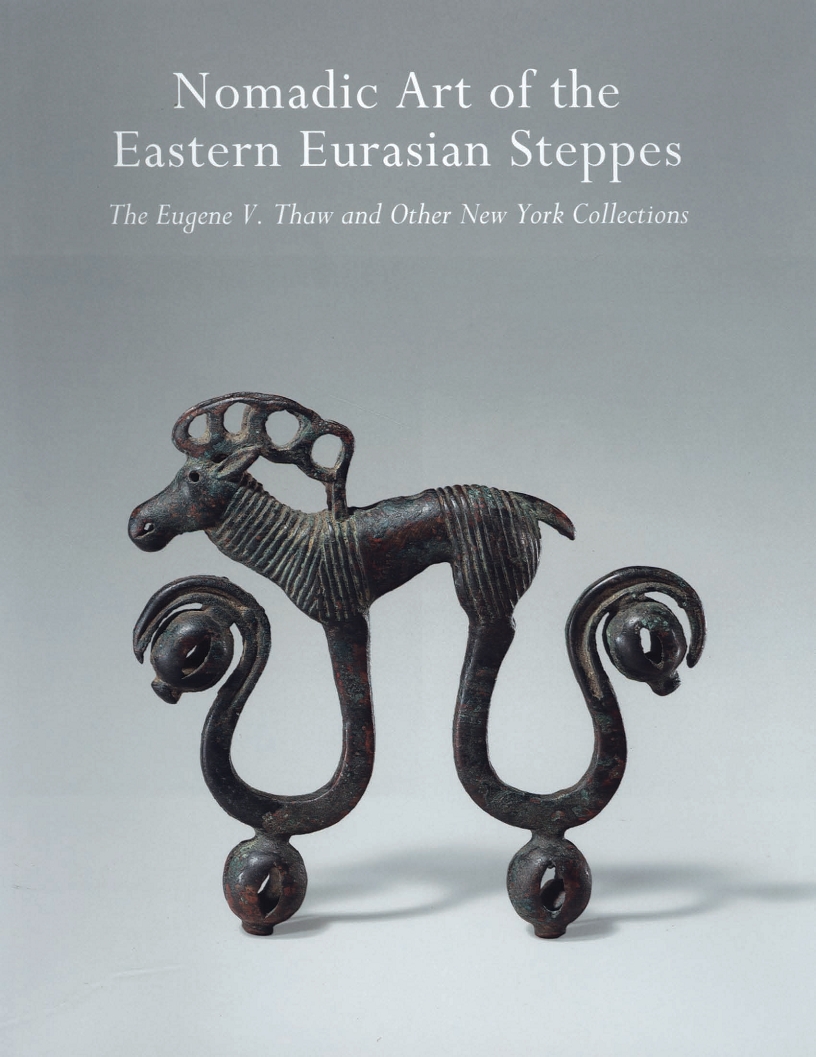Bunker, Emma C., "Nomadic Art of the Eastern Eurasian Steppes:
The Eugene V. Thaw and Other Notable New York Collections"
Publisher: Metropolitan Museum of Art | 2002 | ISBN: 0300096887/1588390667 | English | PDF | 320 pages | 37.39 Mb
The Eugene V. Thaw and Other Notable New York Collections"
Publisher: Metropolitan Museum of Art | 2002 | ISBN: 0300096887/1588390667 | English | PDF | 320 pages | 37.39 Mb
Four thousand years ago a remarkable culture, that of the pastoral nomads, emerged in the Eurasian steppes north of the Great Wall of China, in the vast expanse of grasslands that stretches from Siberia into Central Europe. By the first millennium B.C., material prosperity among the nomads had brought about a flowering of creativity and the evolution of a new artistic vocabulary.
The pastoral peoples left no written record, but the artifacts that remain provide a key to understanding their culture and beliefs. Beautifully crafted and highly sophisticated and abstract in design, these objects are visual representations of the natural and supernatural worlds that guided their lives.
An equestrian people, the nomads produced many objects associated with horses and the paraphernalia of riding. These were embellished primarily with animal motifs. The figures that populate these small objects—ibex and hedgehogs, deer and camels, griffins and dragons—at time exhibit violence and aggression, at times an appealing charm, but always spirit and vitality. This "animal style" would remain a significant source of inspiration in the decorative arts of the Eurasian continent for centuries to come.
The artistic exchange between the pastoral peoples and their settled Chinese neighbors through trade, migration, marriage alliances, and warfare contributed to the cultural development of both groups. This book chronicles that exchange and tells of the legacy of their art, with iconographic analyses and detailed descriptions of nearly two hundred artifacts.
The objects, a recent gift to The Metropolitan Museum of Art, are drawn from the distinguished collection of Eugene V. Thaw, with additional works selected from other New York collections and from the holdings of the Metropolitan Museum.
Director's Foreword
Philippe de Montebello
Acknowledgments
Collector's Foreword
Eugene V. Thaw
Maps
The World of the Eurasian Nomads
North China, Mongolia, and Southern Siberia
Introduction
James C. Y. Watt
The Land and the People
Emma C. Bunker
Artifacts: Regional Styles and Production Methods
Emma C. Bunker
Catalogue
Emma C. Bunker with contributions by Zhixin Sun
1. Horse Harness Fittings
2. Wheeled Transportation
3. Weapons, Helmets, and Tools
4. Belt Ornaments
5. Garment Plaques and Hooks
6. Personal Ornaments
7. Mirrors, Tools for Musical Instruments, and Ceremonial Paraphernalia
8. Vessels and Implements
The Legacy of Nomadic Art in China and Eastern Central Asia
James C. Y. Watt
Bibliography
Philippe de Montebello
Acknowledgments
Collector's Foreword
Eugene V. Thaw
Maps
The World of the Eurasian Nomads
North China, Mongolia, and Southern Siberia
Introduction
James C. Y. Watt
The Land and the People
Emma C. Bunker
Artifacts: Regional Styles and Production Methods
Emma C. Bunker
Catalogue
Emma C. Bunker with contributions by Zhixin Sun
1. Horse Harness Fittings
2. Wheeled Transportation
3. Weapons, Helmets, and Tools
4. Belt Ornaments
5. Garment Plaques and Hooks
6. Personal Ornaments
7. Mirrors, Tools for Musical Instruments, and Ceremonial Paraphernalia
8. Vessels and Implements
The Legacy of Nomadic Art in China and Eastern Central Asia
James C. Y. Watt
Bibliography
Emma C. Bunker is Research Consultant in the Asian Art Department at the Denver Art Museum and a scholar in the art of the pastoral peoples of North China, southern Siberia, and Central Asia.
James C. Y. Watt is Brooke Russell Astor Chairman of the Department of Asian Art at The Metropolitan Museum of Art.
Zhixin Sun is Associate Curator in the Department of Asian Art at The Metropolitan Museum of Art.
James C. Y. Watt is Brooke Russell Astor Chairman of the Department of Asian Art at The Metropolitan Museum of Art.
Zhixin Sun is Associate Curator in the Department of Asian Art at The Metropolitan Museum of Art.
Choice Reviews Online
"… the volume succeeds in presenting both an interesting and scholarly overview of the previously insufficiently studied eastern nomadic art."
"… the volume succeeds in presenting both an interesting and scholarly overview of the previously insufficiently studied eastern nomadic art."





